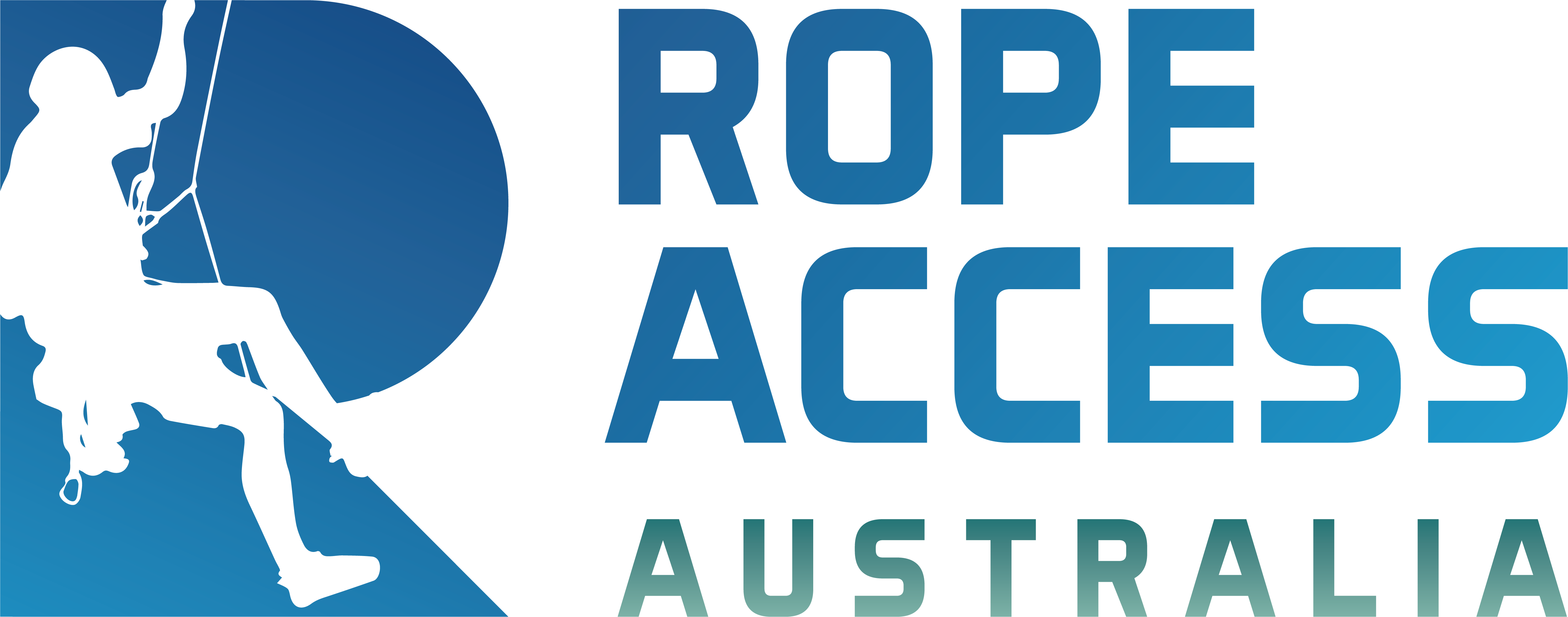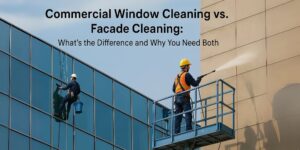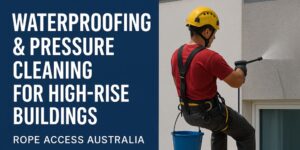High-rises pose challenges to maintenance unlike any other building type—namely high-level pressure washing. As dirt, grime, and natural detritus build up on facades, building managers must choose the best and safest way to access: Rope Access or Elevated Work Platforms (EWPs).
Both types of equipment can create clean surfaces, but in what way they do it—and how they impact your building’s cost, schedule, and safety—differs immensely. In this comprehensive analysis, we will present all that you need to know to make the best decision for your job.
Understanding Elevated Work Platforms (EWPs)
Elevated Work Platforms are mechanical equipment such as boom lifts, cherry pickers, scissor lifts, and truck-mounted platforms. They are generally used in construction, repair, and exterior maintenance.
EWPs’ Advantages:
- User Familiarity: The operators are readily available, and most contractors are familiar with the equipment.
- Tool Transportation: Suitable for use in work that includes heavy tools, water tanks, or specialty tools.
- Stability: Convenient in open, flat spaces where mounting is accessible.
EWPs’ Disadvantages:
- Restricted Access & Reach: EWPs are limited by non-rectangularly shaped buildings, overhangs, and recessed architectural elements. Their limited mobility can’t access complex facades.
- Bulk Equipment & Logistics: Massive access holes, solid foundations, and they’re obstacles. Road closure or traffic re-routing can be necessary.
- High Operating Expenses: Costs mount from equipment rental, transportation, fuel, operator pay, and permits.
- Environmental Impact: Air and noise pollution on use when used with diesel.
- Safety Concerns in Enclosed Spaces: Safe when used correctly, but unsafe when used on uneven terrain or windy conditions.
The Rope Access Advantage: A New Approach to Vertical Maintenance
Rope access uses sophisticated climbing equipment and protection systems to allow technicians to be lowered or ascend the building via ropes, harnesses, and anchors. Initially used for industrial and offshore environments, rope access is now a de facto industry standard method for high-rise cleaning, maintenance, and inspection.
Main Advantages of Rope Access Pressure Cleaning:
1. Unparalleled Accessibility
Whatever the curved glass skyscraper or thin-edged skyscraper with trenches, rope access technicians can reach any structure—horizontally, as well, and vertically. No edge is beyond reach.
2. Greater Speed of Deployment, Completion
Zero or negligible ground space and little equipment are needed with rope access. It can be installed in less than an hour, reducing valuable prep time and cleanup.
3. Cost-Effective Operations
With no need for machines, permits, or additional operators, rope access removes all of the overhead expense. You’re only paying for the technicians, the equipment that they wear, and their experience—not a row of equipment.
4. Improved Safety Record
Despite initial reservations, rope access has one of the lowest incident rates of any access sector. The technicians are IRATA- or SPRAT-trained, highly qualified, and work under strict safety procedures with multiple backup systems.
5. Minimal Impact upon Daily Business
Because there is no necessity to close roads, entry points, or people walkways, rope access enables inhabitants of a building and individuals in general to go about their day normally.
6. Cleanliness of Environment
Rope access eliminates fuel usage with respect to heavy machinery. Most teams use biodegradable cleaning products and low-water-cleaning systems, preventing water usage and environmental effect.
7. Versatility Across Services
Rope access is not only for cleaning. The same methodology can be applied to façade inspection, glazing repair, waterproofing, bird netting, and painting—therefore a long-term exterior maintenance solution.
Head-to-Head Comparison: Rope Access vs. EWPs
| Feature | Rope Access | Elevated Work Platforms (EWPs) |
| Accessibility | Reaches any surface, regar dless of complexity | Restricted by boom reach, terrain, and structure |
| Setup Time | Typically negligible (normally less than 1 hour) | Longer setup, permits, and staging |
| Cost | Lower overall—no machinery renting | Higher—equipment, fuel, transport, labor |
| Safety | Well-trained techs, double-safety systems | Weather, ground, and operator training reliant |
| Environmental Effect | Low—zero emissions, water-saving systems | Moderate to high—diesel engine usage, noise, fuel burn |
| Operational Interference | Low—does not hinder access or entry pathways | Tends to create obstructions and access constraints |
| Transporting Tools | Limited to the tools transported by techs | Capable of carrying heavier loads of equipment or tools |
When EWPs Are Still Justified
- Low-rise structures with large, flat roofs and open space around them.
- Remotely or difficult roof conditions where secure anchors are not present.
- Heavy or fixed equipment operation that cannot be moved along with rope access teams.
In most cases, the ideal solution is a hybrid solution, employing rope access for work near surfaces or vertical use and EWPs for accessible locations or heavy support.
The Bottom Line: Rope Access Takes the Gold
Rope access is the preferred choice for most high-rise pressure washing work as the smart, green, cost-saving solution. It’s designed for speed and safety, providing complete façade access with no machine noise, disturbance, or logistics.
New architecture requires new solutions, and rope access provides them all, making it the maintenance team’s preferred method worldwide.
Simple High-Rise Cleaning With Rope Access Professionals
We are the specialists at Rope Access Australia to provide high-pressure cleaning to the highest and most challenging buildings. Our staff consists of rope access trained technicians skilled to provide spotless clean results with speed, professionalism, and safety.
No matter if you have seasonal staining, pollution buildup, or environmental buildup, we can offer a tailored cleaning program to meet your building’s specific requirements.




